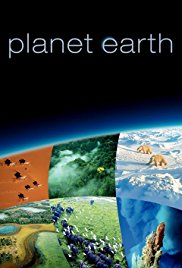PLANET EARTH
The Arctic and Antarctica
Subject: The Environment
Ages: 10+; Elementary – High School;
Length: Clip: 40 minutes, 30 seconds; Lesson: One and a half 45 – 55 minute class periods, depending upon the extent to which the supplementary materials are discussed with the class.
SNIPPET MENU
Using the Snippet in Class:
LEARNING OUTCOMES/OBJECTIVES
Students will be introduced to the Arctic and the Antarctic and some of the fascinating animals who inhabit those regions, including humpback whales, emperor penguins, polar bears, the arctic fox, sea lions, and many others.
RATIONALE
The Arctic and Antarctica are important geological areas seldom directly experienced by people. Watching a film is an excellent way to widen student perspectives and stimulate interest.
DESCRIPTION OF SNIPPET
The clip consists of most of the “Planet Earth” chapter entitled “Ice Worlds”.
HELPFUL BACKGROUND
Polar bears are the world’s largest land carnivore along with the Kodiak bear. It is in the same species as the brown bear and the grizzly bear. Polar bears, brown bears, and grizzlies can mate and have fertile, viable offspring. Polar bears have adapted to living in a cold icy setting. Their paws are larger than any other bears, to distribute their weight when walking on snow or thin ice and to assist when swimming. Polar bears require sea ice for breeding, hunting and sometimes as locations for their dens. The scientific name for polar bears, “Ursus Martimus”, actually means “maritime bear.” While born on land, they spend most of their time at sea, constantly on the sea ice. It is the only place from which they can hunt their favorite prey, seals. They are excellent swimmers, truly at home in the water. Their feet are webbed and they can close their nostrils while in the water. Polar bears have been seen up to 200 miles away from land.
Usually, adult polar bears live solitary lives. However, they have frequently been seen playing together for hours at a time or embracing while sleeping. Polar bear scientist Nikita Ovsianikov describes adult males as having “well-developed friendships”. They are not territorial and only fight during the mating season. At other times, they will play together and have mock fights.
Polar bears live throughout the circumpolar Arctic. Their tracks have been seen as far as the North Pole; however few bears regularly traverse areas north of 82-north latitude.
Scientists believe that there are about 20,000 to 25,000 polar bears still living today. Predictions are that, if the Earth continues its warming trends in the Arctic, around two-thirds of the world’s polar bears could disappear by 2050. In a recent meeting of the International Union for Conservation of Nature (IUCN) Polar Bear Specialist Group, the world’s best polar bear scientists, forecast that out of the 19 polar bear subpopulations, at least eight were declining. At a 2005 meeting, the polar bear was reclassified as vulnerable on the IUCN Red List of threatened species.
In 2008, the U.S. Department of the Interior announced that it was listing the polar bear as a threatened species under the Endangered Species Act. Hunting, poaching, pollution, and industrial disturbances are taking a toll on the bears’ population, yet the biggest threat is malnutrition and starvation due to habitat loss. As the Earth warms, the sea ice shrinks.
PREPARATION
Prepare for class by deciding which of the supplemental materials to present to the class. Cue the DVD to the beginning of the film clip. After playing the clip, present the supplemental materials.
ASSIGNMENTS
Students can be asked to prepare reports in written or oral form concerning: (1) the current condition of polar bears or any other species of animals shown in the film; (2) the condition of the sea ice surrounding Antarctica and Greenland; or (3) any other topic suggested by the film.
SUPPLEMENTAL MATERIALS
- Polar Bears A SeaWorld Education Department Resource;
- Website of Polar Bears International;
- Arctic Bears — How Grizzlies Evolved into Polar Bears from PBS Nature.;
- There are also videos of polar bears hunting and swimming at PBS.
This Snippet Lesson Plan was written by James Frieden and Justin Frieden. It was published on November 16, 2009.

SNIPPET MENU:
Learner Outcomes/Objectives
Rationale
Description of the Snippet
Helpful Background
Using the Snippet in Class:
Location of the Snippet:
The snippet begins about 7 minutes 25 seconds into the Ice Worlds section of the second DVD, when the screen shows the Antarctic Peninsula. It ends at the end of the DVD, as the Planet Earth Diaries begins. Note that minute and second calculations may differ from what is set out below. Check your disc for exact location before using the film in class.
Possible Problems for this Snippet:
None.
Why not show the whole movie?
The only reasons not to show students the entire movie are time constraints and the fact that young minds might not have the attention span for the entire film. Some teachers play the movie in short segments over several weeks.
Search Lesson Plans for Movies
Get our FREE Newsletter!
* we respect your privacy. no spam here!




